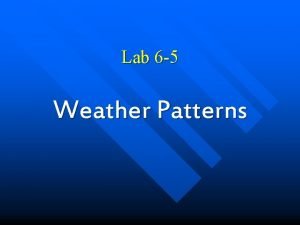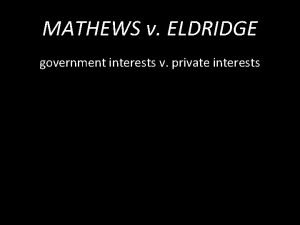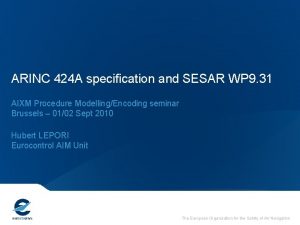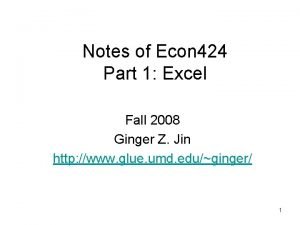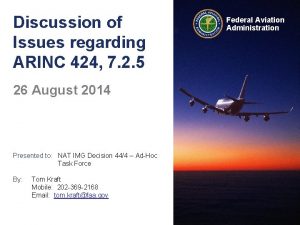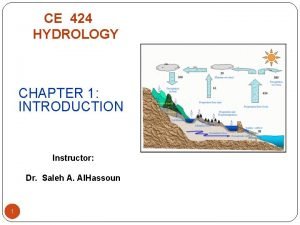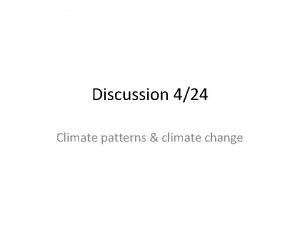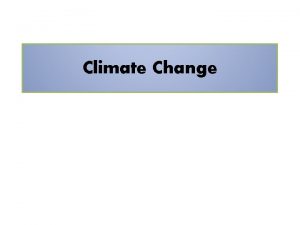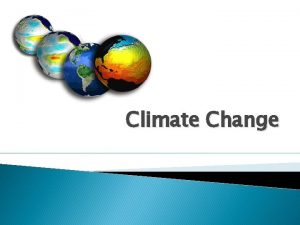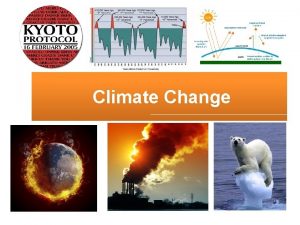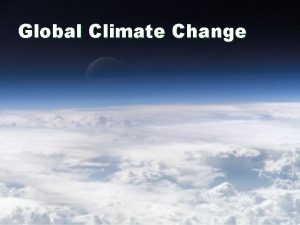Discussion 424 Climate patterns climate change THE CHANGING















- Slides: 15

Discussion 4/24 Climate patterns & climate change

THE CHANGING CLIMATE • Climate involves more than just the atmosphere. • Climate may be broadly defined as the long-term behavior of global environmental system • “To understand fully and to predict changes in the atmospheric component of the climate system. one must first understand the sun, oceans, ice sheets, solid earth, and all forms of life" • Thus we talk about a climate system consisting of the atmosphere, hydrosphere, solid earth, biosphere and cryosphere. • Climate system involves the exchange of energy and moisture among these components

Fig. 14 -3, p. 414


World map of the Kopper climate classification scheme Fig. 14 -2, p. 413

Fig. 14 -3, p. 414

Highland climate (H)

DETECTING CLIMATE CHANGE • DIFFICULT TO DETECT CLIMATE CHANGE EXCEPT OVER LONG PERIODS OF TIME. • INSTRUMENTAL RECORDS GO BACK ONLY A COUPLE OF CENTURIES. THE FURTHER BACK, THE LESS RELIABLE ARE THE DATA. • SCIENTISTS MUST DECIPHER CHANGES FROM INDIRECT EVIDENCE • HISTORICAL DOCUMENTS • TREE RINGS • POLLEN RECORDS • GLACIAL ICE – AIR BUBBLES AND DUST • SEA-FLOOR, MATINE SEDIMENTS. OXYGEN ISOTOPE RATIOS IN FOSSIL SHELLS • FOSSIL RECORDS

CLIMATE CLUES

POLLEN RECORDS • Pollen degrades slowly and each species can be identified by the shape of its pollen • Radioactive carbon dating gives the age of the pollen. • As the climate changes, different types of species become dominant • Hence the pollen record can be used to identify the type of climate that existed

POLLEN RECORDS

ICE SHEETS • Each year snow falls on the ice sheets and glaciers. As it accumulates it compresses and traps air bubbles. • These bubbles of air trapped in ice can be analyzed to determine atmospheric composition. • Glaciers that exist today can hold bubbles that are tens or hundreds of thousand of years old. • Dust in the ice sheets can be caused by climatechanging volcanoes, or dry windy conditions that lead to soil erosion. • Find that the colder periods of the Earth history (20000, 60, 000 and 100, 000 years ago) are usually much dustier

Concentration of Carbon Dioxide and Methane determined from air bubbles in ice cores. Fig. 14 -18, p. 426

MARINE SEDIMENTS/FOSSIL RECORDS • Foraminifera are micro-organisms that live in the sea and have a calcium carbonate shell. Ca. CO 3 • As the foraminifera die they sink to the ocean floor to form chalk deposits. • Among these chalk deposits one also find fossil shells. • Oxygen has two isotopes which have an atomic mass of 16 and 18 • The ratio of these two isotopes in the shells and foraminifera is a function of the sea temperature • Fossils reveal ancient animal and plant life that can be used to infer climate characteristics of the past

NATURAL CAUSES OF CLIMATE CHANGE • • UNRELATED TO HUMAN ACTIVITY. VOLCANIC ACTIVITY ASTEROID IMPACTS SOLAR VARIABILITY VARIATIONS IN THE EARTH'S ORBIT PLATE TECTONICS CHANGES IN THE OCEAN CIRCULATION PATTERNS
 Climate change 2014 mitigation of climate change
Climate change 2014 mitigation of climate change Discussion discussion
Discussion discussion Weather patterns lab answer key
Weather patterns lab answer key Portaria interministerial 424 de 2016 atualizada
Portaria interministerial 424 de 2016 atualizada Mathews v eldridge case brief
Mathews v eldridge case brief Nmos inverter with depletion load
Nmos inverter with depletion load Arinc 424 format
Arinc 424 format Econ 424
Econ 424 Ece 424
Ece 424 Sevicze
Sevicze What is qt
What is qt Arinc 424 waypoint format
Arinc 424 waypoint format Qg 424
Qg 424 Rn424
Rn424 Ece 424
Ece 424 Ece 424
Ece 424


